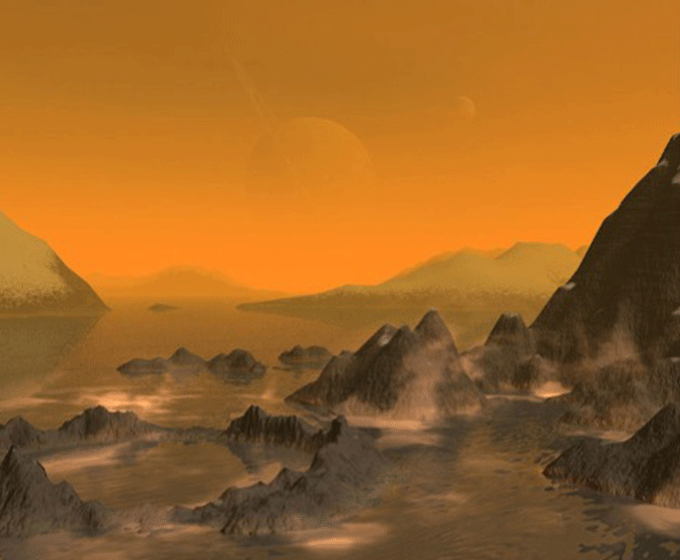
An artist’s rendition of Titan’s landscape features a hazy atmosphere, dark dunes, and lakes and seas that resemble Earth’s. On these bodies of liquid, new research suggests that the appearance of “magic islands” may be caused by floating organic solids. Courtesy of Stan Richard.
JANUARY 5, 2024 — Titan’s “magic islands” are likely floating chunks of porous, icy organic solids, a new study by UTSA professor Xinting Yu finds, pivoting from previous work suggesting they were gas bubbles.
Yu, an assistant professor in the UTSA Department of Physics and Astronomy, led the study published in Geophysical Research Letters, the American Geophysical Union’s journal for high-impact, short-format reports with immediate implications spanning all Earth and space sciences.
Saturn’s largest moon, Titan, is blanketed in an unusually thick atmosphere full of organic molecules; its surface is covered with dark dunes of organic material and seas of liquid methane and ethane. But one of Titan’s strangest phenomena appears in radar imagery as shifting bright spots of the liquid bodies’ surfaces that can last a few hours to several weeks or more.
The “magic islands” were first spotted in 2014 with the Cassini-Huygens mission. Scientists have since been trying to figure out what they are.
Previous studies suggested that these ephemeral islands could be phantom islands caused by waves or real islands made of suspended solids, floating solids, or bubbles of nitrogen gas. Yu wondered if a closer look at the relationship between Titan’s atmosphere, liquid lakes, and the solid materials deposited on the moon’s surface could reveal the cause of these mysterious islands.
 Xinting Yu
Xinting Yu“I wanted to investigate whether the magic islands could actually be organics floating on the surface, like pumice that can float on water here on Earth before finally sinking,” she said.
The fate of these organic clumps after they reached Titan’s liquid bodies interested Yu and her team. They first investigated whether Titan’s organic solids would simply dissolve in the moon’s methane lakes. Because the lakes are already saturated with organic particles, the team determined that the falling solids would not dissolve when they reached the liquid, at least quickly.
“For us to see the magic islands, they can’t just float for a second and then sink,” Yu said. “They have to float for some time, but not for forever either.”
The researchers then explored two ways the frozen solids could float: capillary force and porosity.
Titan’s lakes and seas are primarily methane and ethane, both of which have low surface tension — and a lower surface tension makes it harder for solids to float. The models suggested that most of the frozen solids were too dense, and the surface tension is too low, for capillary forces alone to create Titan’s magic islands.
The team turned to porosity for an explanation. If the icy clumps were large enough and had the right ratio of holes and narrow tubes, the liquid methane could seep in slowly enough that the clumps could linger at the surface.
Yu’s modeling suggested individual clumps are likely too small to float by themselves. But if enough clumps massed together near the shore, larger pieces could break off and float away, similar to how glaciers calve on Earth. With a combination of a bigger size and the right porosity, these organic glaciers could explain the magic island phenomenon.
In addition to the magic islands, a thin layer of frozen solids coating Titan’s seas and lakes could explain the liquid bodies’ unusual smoothness. Thus, the findings from this study could explain two of Titan’s mysteries.
“I’ve known about the magic islands since I started grad school, but I never thought I’d be able to contribute to understanding them,” Yu said. “It feels great to make some discoveries myself.”
The study was a collaborative effort with Yue Yu of the University of California at Santa Cruz and University of Geneva, Julia Garver of the University of California at Santa Cruz, Xi Zhang of the University of California at Santa Cruz and Patricia McGuiggan of John Hopkins University.
Yu’s research focuses on various atmospheric and surface processes of Titan. She recently established a Planetary Material Characterization Facility at the UTSA Main Campus, where she provides UTSA students with opportunities in planetary research.
Her research team is currently creating an authentic database cataloging planetary and exoplanetary properties to enhance scientists’ understanding of planetary atmospheres and surfaces.
UTSA Today is produced by University Communications and Marketing, the official news source of The University of Texas at San Antonio. Send your feedback to news@utsa.edu. Keep up-to-date on UTSA news by visiting UTSA Today. Connect with UTSA online at Facebook, Twitter, Youtube and Instagram.
Move In To COLFA is strongly recommended for new students in COLFA. It gives you the chance to learn about the Student Success Center, campus resources and meet new friends!
Academic Classroom: Lecture Hall (MH 2.01.10,) McKinney Humanities BldgWe invite you to join us for Birds Up! Downtown, an exciting welcome back event designed to connect students with the different departments at the Downtown Campus. Students will have the opportunity to learn about some of the departments on campus, gain access to different resources, and collect some giveaways!
Bill Miller PlazaCome and celebrate this year's homecoming at the Downtown Campus with food, games, giveaways, music, and more. We look forward to seeing your Roadrunner Spirit!
Bill Miller PlazaThe University of Texas at San Antonio is dedicated to the advancement of knowledge through research and discovery, teaching and learning, community engagement and public service. As an institution of access and excellence, UTSA embraces multicultural traditions and serves as a center for intellectual and creative resources as well as a catalyst for socioeconomic development and the commercialization of intellectual property - for Texas, the nation and the world.
To be a premier public research university, providing access to educational excellence and preparing citizen leaders for the global environment.
We encourage an environment of dialogue and discovery, where integrity, excellence, respect, collaboration and innovation are fostered.